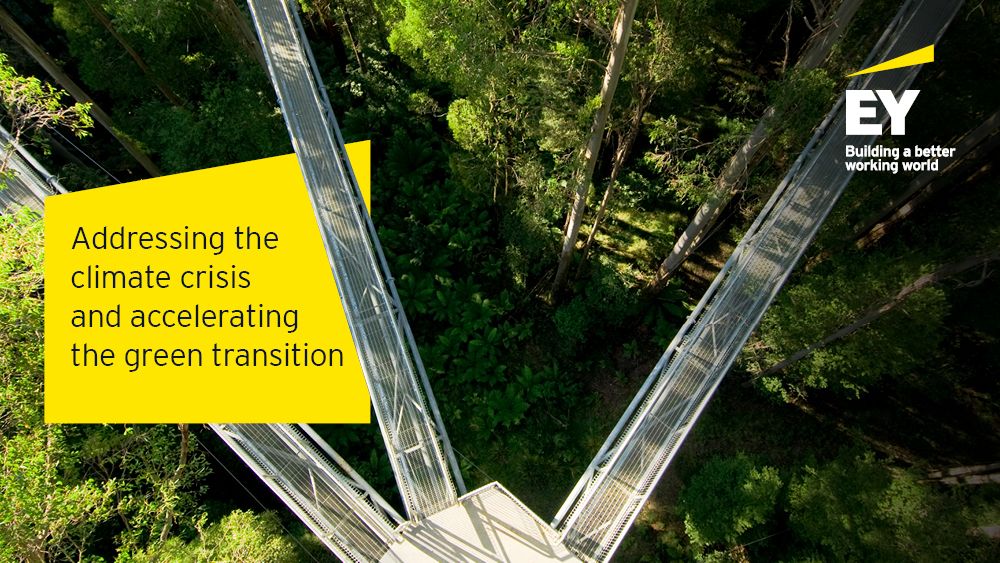Addressing the climate crisis and accelerating the green transition
Read this new piece from EY as Dr. Gianluca Di Pasquale shares valuable recommendations to navigate our critical path toward a sustainable future, including a combination of policies, incentives, and public/private-sector collaboration.

In the 21st century, we grapple with unprecedented challenges like the climate emergency and disruptive technological advancements. All recent reports from the IPCC highlight a continuous rise in emissions (excluding the pandemic year). Experts say the world is projected to overshoot the carbon budget much earlier than expected by 10 to 15 years. The urgency to address the climate crisis has never been greater, and it’s the responsibility of governments to act swiftly and decisively, leading the charge in a just transition away from fossil fuels. Today, I share insights from a collaborative research effort between the EY organization and the esteemed academic economists and public policy experts at Politecnico di Milano in Italy. Our findings offer valuable recommendations for governments to navigate our critical path toward a sustainable future, including a combination of policies, incentives, and public/private-sector collaboration.
Carbon pricing: empowering change through economic incentives
Governments have been too timid regarding climate regulation for too long, fearing that stricter emissions standards could push key industries to relocate to countries and regions with more relaxed policies. However, today, the business world is aware that the price of carbon will continue to rise and is looking for leadership and certainty.
Governments play a vital role in transformative change, and if they lead, businesses will follow. One powerful tool at their disposal is effective carbon pricing. Implementing clear and binding carbon pricing mechanisms, such as carbon taxes or emissions trading systems, can have a profound, positive impact. By accurately reflecting the true costs of greenhouse gas emissions, governments can incentivize the adoption of low-carbon behaviors and technologies. Higher carbon prices and a broader application of pricing mechanisms can accelerate the transition to green energy by 2050 and generate government tax revenues ranging €15 trillion to €80 trillion globally.
This economic incentive drives the transition to a sustainable economy and encourages investment and innovation in low-carbon solutions. Indeed, a price on carbon aligns with the "polluter pays" principle in global environmental law by employing a market-based approach. Carbon pricing enables governments to fulfill climate commitments while ensuring a just transition that balances economic growth and environmental responsibility. For example, Ghana’s Environmental Protection Agency is setting milestones on generating practical cases for Article 6.2 implementation in the country to open possibilities to leverage the potential for the private sector to step in and provide climate finance for mitigation projects[1].
Green technology: unleashing innovation for sustainable progress
Technological innovation is a linchpin of the green transition, and governments must seize the opportunity to lead the way. Action plans and policies must provide credible pathways to limit temperature growth and improve everyday citizens' and future generations' quality of life. Our research highlights the significance of existing and emerging green technologies in achieving ambitious climate goals. We have outlined a concerning scenario (under existing policies) where investments and technologies still show a 56% emissions gap and 700 Gt of carbon still to be released by 2050. Therefore, current decarbonization policies and commitments are still not enough to deliver net zero. The public sector must adopt a more proactive approach and foster deeper international cooperation. A successful example of such an approach is the expected expansion of offshore wind farms in Europe’s North Sea, a combined effort by nine countries.[2]
Governments can foster innovation and accelerate the deployment of sustainable solutions by strategically investing in research and development. The possibilities are vast, whether it’s carbon capture, hydrogen-fueled engines, clean batteries, or sustainable biofuels. However, while great progress has been made in greening energy vectors, accelerating the transition of breakthrough technologies from the lab to commercial stages is essential.
Governments must create an enabling environment encouraging public-private partnerships and incentivizing private-sector investments in green technology. The potential for clean technologies is clear to all. Achieving the right balance between policy frameworks and investments in scalable technologies, reshaping blended finance, and leveraging public-private partnerships to drive investments will be crucial for success. By doing so, we can unlock the economic potential of the green economy, creating new industries and job opportunities while reducing our dependence on fossil fuels.
Sustainable jobs: nurturing a resilient workforce
As our climate crisis intensifies, the challenges governments face will only increase. Shifting to a green economy requires more than just creating and replacing jobs; it demands a fundamental labor market restructuring to ensure a sustainable and equitable transition. Current trends show a growing demand for green skills and environmentally conscious workplaces among employees and students, underscoring the need for governments to invest in education and training programs.
According to our research, the green transition will shape a new employment ecosystem: By 2050, up to 150 million new jobs will be added along green value chains. While the challenge is immense, effective leadership — planning and acting now — will help shape a future that benefits future generations and cements positive legacies. Governments have a critical role to play in nurturing a labor market that can thrive in the transition to a sustainable economy.
Our research emphasizes the importance of investing in education and training programs that equip individuals with the skills needed for green jobs while leaving nobody behind. Governments need to create a positive impact not just in terms of employment but also equity and inclusiveness by collaborating with educational institutions, industry stakeholders, and workforce development agencies to develop comprehensive training initiatives. A smooth and inclusive transition can be ensured by prioritizing re-skilling and upskilling programs and creating pathways for workers in traditional industries to participate in the green economy. Building a sustainable workforce is about environmental stewardship and creating a more equitable and prosperous society.
The collaborative research effort between the EY organization and Politecnico di Milano offers valuable insights for governments as they help lead us toward a sustainable future. Governments can accelerate the green transition and achieve their climate goals by implementing effective carbon pricing mechanisms, investing in green technology, and nurturing a resilient workforce. Let’s seize this opportunity to propose transformative policies, guide governments, and shape a just, sustainable future for generations to come. The time to act is now, and the power to make a difference lies with all of us — with governments playing a pivotal role in driving necessary change.
Read the full article to learn more.
Contributor: Marco Cavalli, Manager, EY Advisory S.p.A.
The views reflected in this article are the views of the author and do not necessarily reflect the views of the global EY organization or its member firms.






